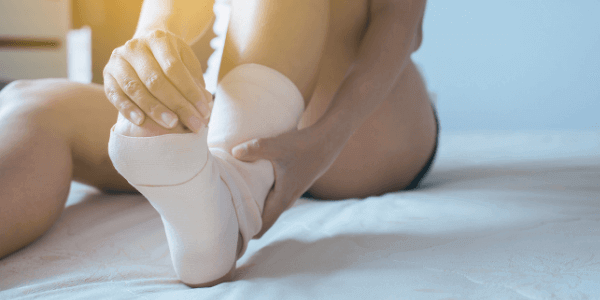Is minimally invasive foot surgery right for you?

Minimally invasive foot surgery is a type of surgery that can be used to treat various different foot problems
Patients having this kind of surgery have an easier recovery period than those undergoing older, open surgical techniques that cause more trauma to the soft tissues in the foot.
Mr Lloyd (Robert) Williams is an orthopaedic surgeon at King Edward VII’s Hospital and specialises in foot and ankle surgery. He’s also a founding partner of The London Orthopaedic Clinic based at King Edward VII’s Hospital.
Here, we speak to Mr Williams about minimally invasive foot surgery, what foot problems it can help to treat and what the recovery is like.
What is minimally invasive foot surgery?
Minimally invasive foot surgery is a relatively new surgical technique that isn’t yet carried out routinely. During this kind of surgery, standard foot and ankle operations can be performed using very small surgical instruments through very small incisions, or cuts.
There are many types of foot surgery that can be carried out using this technique, including a bunionectomy, surgery to treat bunions. Bunions are a common foot condition that causes a bony lump protruding from the outer base of the big toe.
Standard, open foot and ankle surgeries often involve larger surgical instruments such as powered saws and larger incisions, causing greater trauma to the area.
Carrying out minimally invasive foot surgery means that patients benefit from less pain after surgery, less swelling and stiffness, smaller scars and a quicker return to normal function.
Minimally invasive foot surgery was pioneered by specialist foot surgeons in America. It has since become established in the UK and parts of western Europe.

What conditions can be treated by minimally invasive foot surgery?
Many foot and ankle conditions can be treated using minimally invasive foot surgery. These include:
- Bunions
- Bunionettes (similar to bunions but on the small toe rather than the big toe)
- Hammer toe
- Other toe deformities
- Arthritic bump removal from joints
- Heel bone spur removal
- Flat foot correction
- High arch correction
- Abnormal bone growth removal to prevent under foot ulcers in diabetics
Anyone with one of these foot conditions can have minimally invasive foot surgery. It can be especially beneficial in those with skin or blood supply problems to the foot where open surgery may not be suitable due to wound healing issues.
Minimally invasive foot surgery is different to arthroscopic surgical procedures that treat the joints, such as ankle arthroscopy.
How different is the recovery from minimally invasive foot surgery?
Minimally invasive foot surgery causes less trauma to the soft tissues within the foot. This means that the soft tissues will recover more quickly than after open foot surgery.
There will also be less bruising, swelling and stiffness following minimally invasive surgery and the foot will appear closer to normal following surgery.
However, if the bones are cut, whether during minimally invasive foot surgery or open foot surgery, they will still take the same amount of time to heal. Also, regardless of the type of surgery, the foot will still need to be elevated for a certain amount of time following surgery, depending on the surgery that’s been carried out.
Anyone having any kind of foot surgery will require rest and recouperation following surgery, whether minimally invasive foot surgery or open foot surgery. However, patients who have had minimally invasive surgery generally feel that they can walk and get around more easily in the early stages of recovery due to less swelling and stiffness.
Although recovery from minimally invasive foot surgery is slightly quicker than for open foot surgery, it’s better to view the recovery from minimally invasive foot surgery as “easier” rather than quicker. Especially so if the surgery involves cutting the bones (which depends on your foot condition and the type of surgery being carried out).
What can I do to help my recovery?
It’s essential that in the two weeks following minimally invasive foot surgery that you keep your foot elevated when resting. During this time, moving your calf muscles and wiggling your toes regularly is also important.
You can also help your recovery by making sure you avoid standing still on your foot, or allowing your foot to hang down when sitting or lying for more than 15 to 20 minutes at a time during the first two weeks following surgery.

How soon until I can do normal things such as flying?
Full recovery from any kind of foot surgery will depend on the type of surgical procedure you’ve had and the condition it’s treating. After some procedures you may need to wear a special post-operative shoe, for example after a bunionectomy, for a few weeks.
The first two weeks following surgery are the most important, and you should follow your surgeon’s advice closely.
Most people can return to their usual activities six weeks after surgery, but again, your surgeon will advise you on your personal circumstances.
The rules for flying after foot surgery are the same whether you’ve had minimally invasive or open foot surgery. It’s generally advised that you wait at least three weeks following surgery before you fly short haul, or eight weeks if flying long haul. It may be possible for you to fly long haul after only three weeks if you’re flying business class with the use of a flat bed. Check with your surgeon if you’re unsure.
Are there other things I need to consider before having minimally invasive foot surgery?
All surgical procedures carry some level of risk and are associated with complications such as wound infections, blood clots and nerve injury, and foot surgery is no different.
However, these risks are less common following minimally invasive surgery than open surgery. This is due to the smaller wounds and lower level of soft tissue trauma as well as a shorter operation time.
Finally, minimally invasive foot surgery is a new technique and requires a surgeon with a lot of experience. Therefore, not all orthopaedic surgeons are yet able to offer this kind of surgery.
More information
- If you have a foot problem that’s bothering you, speak to your GP who may be able to refer you to a specialist orthopaedic doctor. (If you don’t have a GP, you can make an appointment with one of our private GPs.)
- The King Edward VII’s Hospital Orthopaedic Surgery department is a world famous centre of excellence for orthopaedics offering minimally invasive foot surgery and bunionectomies.










